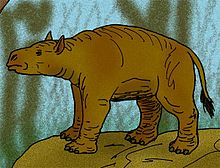Carodnia
|
Carodnia Temporal range: Paleocene - Eocene |
|
|---|---|
 |
|
| Carodnia vieirai | |
| Scientific classification | |
| Kingdom: | Animalia |
| Phylum: | Chordata |
| Class: | Mammalia |
| Subclass: | Theria |
| Infraclass: | Eutheria |
| Superorder: | †Meridiungulata |
| Order: |
†Xenungulata Paula Couto 1952 |
| Family: |
†Carodniidae Paula Couto 1952 |
| Genus: |
†Carodnia Simpson 1935 |
| Species | |
|
|
| Synonyms | |
|
Ctalecarodnia Simpson 1935 |
|
Ctalecarodnia Simpson 1935
Carodnia is an extinct genus of South American ungulate known from the Paleocene of Brazil and Argentina, and the Eocene of Peru.Carodnia is placed in the order Xenungulata together with Etayoa and Notoetayoa.
Carodnia is the largest mammal known from the Paleocene of South America. It was heavily built and had large canines and cheek teeth with a crested pattern like the uintatheres to which it can be related. In life, it would have been a tapir-sized animal. It bore strong resemblances to dinoceratans, although without tusks or ossicones.
Simpson noted that Carodnia resembles the primitive unitathere Probathyopsis. Although Paula Couto also made the same favourable comparison, he placed Carodnia in the new order Xenungulata. Gingerich 1985 concluded that Probathyopsis shares several dental characteristics with Carodnia, but that in the latter the anterior dentition of is more reduced, the second lower and upper premolars are enlarged and pointed, and that the first and second molars are more lophodont. Gingerich thought the differences could justify a separate family for Carodnia but proposed that it should be included in Probathyopsis. Cifelli 1883 grouped Carodnia with Pyrotheria but later concluded that this was a mistake.
Carodnia is characterized by bilophodont first and second molars and more complex lophate third molars, which suggests possible links to pyrotheres, uintatheres, and even . The bones of the foot are short and robust and the digits terminate in broad, flat, and unfissured hoof-like unguals, unlike any other known meridiungulate.
C. feruglioi and C. cabrerai (from the Riochican SALMA of Patagonia) are known from only a few dental remains. C. vieirai (from the Itaboraian SALMA of Itaborai) is known from much more complete dental, cranial, and postcranial remains including an almost complete mandible, many vertebrae, and several partial leg bones.
...
Wikipedia
